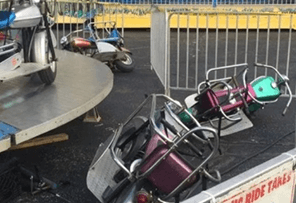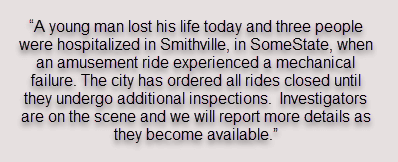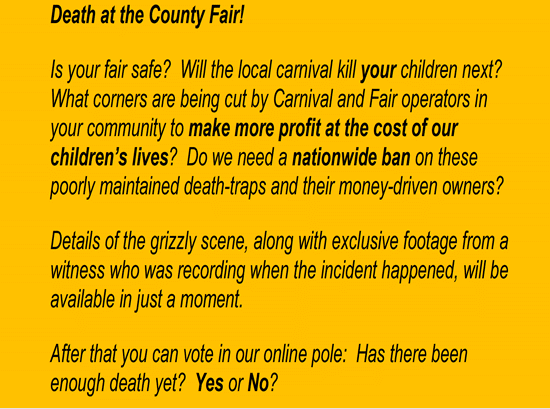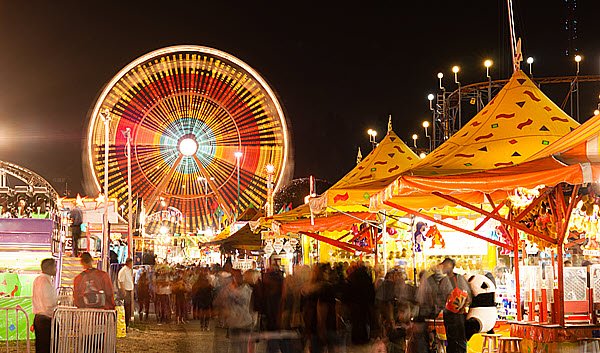Carnival Catastrophe: Is there a Real Reason to be Afraid?
Counties and Cities with Carnivals or Fairs
There are over 3,000 counties in our country. There are almost 20,000 cities and towns. Just about every one of them has at least one carnival or fair, and in the case of the bigger cities, perhaps dozens every year.
According to data from the Consumer Product Safety Commission (CPSC) it comes in at about 4,400 injuries annually but only about 1.5% of that number (66) require hospitalization each year. Complied statistics for (non-Amusement Park) carnival and fair injuries or deaths are calculated to be 6 per 100,000 visitors, or 0.006%.
Not only is the number quite small, but the classification of injuries is quite broad, including anything requiring treatment or hospitalization. Everything from twisted ankles or sprains, bumped heads, chest pains, numbness, neck strains, back pain, dizziness, and vomiting all count.
If you were to pick a large amusement park, such as Disney World with its 19.33 million visitors each year, and apply those statistics, you might expect 1,160 injuries per year. Big parks are actually much better than that because they have permanent equipment that stays in one place, and experienced maintenance crews with multiple inspections per day.
An actual Carnival incident
In July (2017), when one of the rides at the Ohio State Fair experienced a severe failure, an 18-year-old man was killed. A further six were injured. Despite undergoing three separate inspections, by the operator, the city officials, and an independent third party, they all missed some significant corrosion for one of the seating areas. The metal was thin enough to shear when the ride was under strain with a full load of passengers.
Who is to blame?
 In this particular case, the manufacturer had issued a notice about the fault in the ride considerably earlier. They had notified, or attempted to notify, all purchasers, of the potential danger of failure and recommended not using the ride until repairs could be effected.
In this particular case, the manufacturer had issued a notice about the fault in the ride considerably earlier. They had notified, or attempted to notify, all purchasers, of the potential danger of failure and recommended not using the ride until repairs could be effected.
These carnivals and fairs do a lot of traveling, meaning that equipment is assembled and disassembled daily or weekly, moving from one location to the next. It might be hard to keep up with notices, warnings, alerts, or changing maintenance requirements when you’re constantly on the go. But perhaps, you would think, workers familiar with the equipment might notice changes and deterioration.
Except that they might not… It might be invisible because it is encased in fiberglass, or in other ways hidden from view. And the fact is, carnivals and fairs have a constant flow of workers joining or leaving, so responsibility for setting up any given machine might be the responsibility of a different person every time.
The city/town inspectors are most likely civil engineers, so a visual inspection might reveal major flaws. The inspectors are unlikely to carry a torque-wrench and check every single bolt on the ride to make sure it is exactly 155 lb-ft (pound-feet is a tightness design requirement for each sort of bolt) or whatever is specified.
Finally, the independent Third Party inspector might not know about a particular ride, such as where stresses exist, how loading affects its operation, or even the specifications that constitute safe and proper assembly. They may be knowledgeable, but they can’t know everything.
Kiddie Carnival Rides
 Sometimes things just happen despite our best efforts. With all rides, the risk is rather low, and kiddie rides are generally extra safe. Back in 2015, a motorcycle ride in Market Square (Lafayette, Indiana) had an incident where some little pretend motorcycles detached from the ride with kids on them. One girl hurt her wrist and a boy had a bleeding mouth.
Sometimes things just happen despite our best efforts. With all rides, the risk is rather low, and kiddie rides are generally extra safe. Back in 2015, a motorcycle ride in Market Square (Lafayette, Indiana) had an incident where some little pretend motorcycles detached from the ride with kids on them. One girl hurt her wrist and a boy had a bleeding mouth.
As you can see, the mini-motorcycles have seat belts and plenty of railing to protect the passengers. The ride opened a day before the inspectors were due to arrive, and someone overlooked the safety pins that keep the motorbikes in place.
In truth the biggest danger comes from carousel rides because of the sorts of seating, and the “All Ages Allowed” policy. 21% of all injuries originate there as opposed to just 10% from roller coasters and 4% from Bumper Cars.
It is quite acceptable to conclude that you should feel safe to enjoy your family day out at the local fair. The risks are quite low particularly if you see something that looks poorly maintained and stay away from it.
Insurance for the Carnivals
In the unlikely event that something actually was to go wrong, cities, towns, and states require that operators maintain adequate insurance. Otherwise they won’t issue them a permit at all. The cost of the insurance is substantial, but it goes higher if they have accidents and experience claims. This incentivizes these businesses to keep their equipment in good running order to assure client safety.
What does the insurance cover? Anything required, from midways, to food, to rides, to fire, to motorized trackless trains to move people around the fairgrounds. Covering those items is as important as the rides, since they all represent hazards in some way or another.
The Takeaway on this Carnival Issue
So why is there such excessive reporting when an accident occurs? Once it gets onto the wire services it will be reported by every news outlet. If it is shocking, worrisome, and attracts a lot of viewers, it gets a lot more attention.
Unfortunately, modern “news” has become similar to “Show Business” in the last decade, completely driven by ratings. Something that is flashy, controversial, or frightening gets more coverage than genuine news that could affect us as individuals, or collectively as a country.
You may have heard the term “Fake News” a lot in the last year or so, but it has been going on for quite a while. It’s up to us to pay less attention to sensational news, and demand more legitimate news designed to inform us rather than make us angry or scared. Would you rather see real news reporting, like the first example, or fake news, like the second example?


So enjoy your time at the local fair. You should feel secure enough to experience your local carnival without worry. Don’t let exploitative journalism ruin your family fun, where you are probably safer than when you are when crossing the street!
Common sense may be less “common” than it should be, but feel free to use it on a regular basis. If a ride doesn’t look safe, then don’t ride on it. If a vendor looks unsanitary or poorly maintained, don’t buy food there. It really is that simple.




Leave A Comment